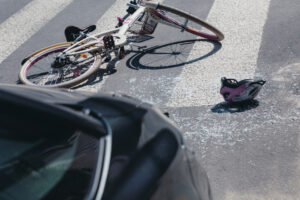There are some basics to bicycling safety which most of us learned as children. So, why did some of us forget fundamental bicycle safety rules, as rudimentary as wearing a helmet? Would you let your child ride without a helmet? Then why is it less important to wear a helmet as an adult? Helmets are not just necessary for downhill mountain bikers traversing the single-track trails or for street racers. The bicycle helmet is a key piece of equipment you should not leave home without.
Why am I qualified to get on this soapbox? The simple reason is that I have for decades been representing cyclists after they have been in bicycle accidents. I have seen the difference in the injuries sustained in bicycle crashes and helmets really do make a difference. And the greatest difference I personally have observed is in the low to medium speed bicycle accident.
While we often feel like a bicycle ride on a path next to the beach is slow and safe, as soon as we mix bicycles and motorists on the same roadway, we now have a much larger potential for head injuries. Head injuries are the most common way for cycling to lead to death.
In a busy intersection shared by both cars and bicycles, such as on Old San Jose Road in Santa Cruz, another bicycle fatality where the cyclist was not wearing a helmut has occured.
Last week cyclist Noel Hamilton was involved in the second fatal hit-and-run accident involving a bicyclist in June in Santa Cruz. In this case, the driver actually returned to the location of the accident to cooperate with police, but it was too late for the cyclist.
There were other satety basics that were lacking in both of these hit and run accidents. Not only were the riders lacking head protection, but they also were missing lights and reflective gear. These accidents do more than point out the horrific hit-and-run issues with cyclists in Santa Cruz. They also demonstrate troubling statistics relating to rider safety. Sadly, Santa Cruz County’s rate of 74 accidents per 100,000 residents is double that of the statewide average.
Wrongful death can occur even in this laid back beach town, home of many surfers who ride bicycles while carrying their surfboards to the beach in one arm. With their minds on surfing, it may be tough to plan a safe ride to and from the beach.
The truth is that head injuries are usually catastrophic. Traumatic brain injuries dramatically affect the lives of brain injured people and their families. In many cases, these injuries leave individuals permanently disabled, or in need of months, and sometimes years, of rehabilitation and therapy. It is often important to consult with a California traumatic brain injuries (TBI) lawyer to make sure injured clients and their families have the resources they need to deal with these drastic changes.
About the author: Claude Wyle is an aggressive advocate for Bay Area bicyclists. Claude has decades of experience representing those harmed by the wrongful conduct of others, and, as a Bay Area bicyclist and accident lawyer, has fought to protect the rights of injured cyclists throughout his legal career. Claude is also an avid cyclist himself and member of the Marin County Bicycle Coalition, San Francisco Bicycle Coalition and Silicon Valley Bicycle Coalition.
"if it is predictable, it is preventable."

Claude A. Wyle is a partner of Choulos Choulos, and Wyle, a San Francisco based law firm dedicated to representing clients who have been injured by the wrongful conduct of individuals, corporations, public entities, and businesses. Mr. Wyle also frequently sits as a Judge Pro Tem for the city and county of San Francisco.










8 Comments
Dave
I love the way that a bike 'advocate' blames the victims of crimes. If only we'd all wear helmets, we save so many more cyclist lives....Sorry but that is just wrong.
Cyclists are killed by being hit by a motor vehicle. They don't die from not wearing a helmet. The answer lies in stopping cyclists the cause of the danger, not dressing them up like christmas tree like crash test dummies.
Think of it this way - when you hear about someone being shot, is your first though "why did some of us forget fundamental gun safety rules, as rudimentary as wearing a bullet proof vest?". No, you realize that it could happy to anyone and the proper response is to stop people shooting each other, not advocating for bullet proof vest or more gun training.
We should try and learn from the people who do cycling right. In the Netherlands, their fatality rate is 1.1 cyclists per 100,0000,000 (billion) kms ridden. They don't promote helmet use because they know a helmet does little against being hit by a car at 30mph. The fatality rate in the US on the other hand is 5 times higher, yet helmet wearing is 20 times higher. The math is pretty simple.
Michael
Dave is apparently an anti-helmet ideologue. The death rate you quote is off by a factor of 1000, by the way, but that is irrelevant. Cycling is safer in the Netherlands, but that doesn't mean that the death rate wouldn't be even lower if Dutch cyclists wore helmets. It would, and many have suggested it. http://bit.ly/qLC3lP The gun analogy is silly: the PURPOSE of guns is to kill people, the purpose of cars and bicycles is transportation. The notion that there is no point to wearing helmets is just not borne out by the data. While it may be the case that if the US became as bicycle-centered as the Netherlands that our mortality rates would be the same, the likelihood of the US doing that is not close to zero, it is zero. Dave can move to the Netherlands, but I'll keep wearing my helmet, plus my lights, plus my reflective gear.
Dave
Michael is apparently more interested personal attacks than evidence. Far from being 'anti-helmet ideologue', I think helmets can be beneficial in many circumstances, but their promotion as the primary safety intervention for cyclists is both unsupported and dangerous.
There is a clear connection between cycling safety and cycling numbers - the more people who ride, the lower the injury & fatality rate. There is also a clear connection between helmet laws and reduced cycling - countries like Australia and NZ saw a 30%+ reduction in cycling numbers when they introduced helmet laws. Discouraging cycling by focusing on dangers (such as promoting helmet use when the risk of head injury is the same as driving and walking) actually makes cycling more dangerous.
You can't have high helmet usage with high cycling numbers. If more people wore helmets in the Netherlands (currently less than 2% of cyclists), they would have fewer cyclists, more motorists and higher fatality rates.
Cycling is an inherently safe activity - its about as dangerous as walking. The primary danger comes from being hit by motor vehicles. Focusing safety measures on marginal protection when hit by a car is a very poor way to improve safety. Rather, the cause of the harm should be addressed.
Clearly there is a difference between cycling in the US and NL but the dutch were just as car dependent in the '70s as the US is today. And no one should prevent you from wearing a helmet and shiny vest if you want. Feeling the need to wear a helmet is a good indicator that the cycling environment is not safe enough. But if you want to make cycling safer, then you need to focus on interventions that work.
PS - You don't need to go to Europe for better cycling. NYC recently implemented separated bike lanes which resulted in a 20% drop in road injuries.
PPS - The fatality rate in the Netherlands should have read 1.1 per 10^8kms. The comparison with the US remains the same at over 5 times (5.8 per 10^km) - PucherJ,BuehlerR.Makingcyclingirresistible:LessonsfromThe Netherlands, Denmark and Germany. Transport Reviews, 2008; 28(4), 495-528.
Brandon West
bike lanes NY: http://www.youtube.com/watch?v=bzE-IMaegzQ
ride2wk
Dave is correct - helmets are OK for some circumstances and some people but promoting helmets generally makes it sound like cycling is more dangerous than it really is. In the UK far more people are injured falling out of bed than cycling but I don't see calls for bed heights to be lowered or padded floors around beds!!! So is promoting helmets really the best thing to promote for the best overall public health benefit? There are far more other things that cause far more damage to society than cycling head injuries that people should be fixing before they whinge that cyclists should wear helmets.
Bike helmets have also strangled some kids to death at home or on play equipment after the helmet caught on something high. Wrapping people in cotton wool can actually make some things more dangerous. In the case of cycling helmets a UK study by Ian Walker found cars cut closer to cyclists with helmets on than without. Helmets can lead to some "risk compensation" effects that offset their effectiveness.
I've been cycling in Australia since the 1970's. Helmets were made mandatory in 1991 and it saw a 30% decline in cycling numbers especially for kids and casual riding. That lead to more obesity / health problems, unsafe drivers, less cycling "safety in numbers", more traffic congestion and more air pollution. It was a social failure that all other countries should learn from.
Helmets may help in some situations but they are only the last line of defence and not nearly as effective as more people cycling and building better facilities.
By all means wear a helmet if you prefer but the promotion of helmets probably does more harm than good overall.
Opus the Poet
One of the things that annoys the *ell out of me on these articles is 1) citing the ridiculous 85% reduction in head injuries statistic that has been debunked repeatedly (if helmets really reduced head injury by 85% then they also reduce leg injury by 77%, because that was the reduction in cycling leg injuries when the helmet law in Australia went into effect) and 2) bicycle helmets are designed to prevent skull fractures at impact speeds of 12.5 MPH and lower. A lot of the confusion results from conflating bicycle and motorcycle helmets togehter when they are two entirely different creatures.
Claude Wyle
Hi all,
Thank you for carrying on a discussion while I'm gone and answering each others questions. Much appreciated.
I am always an advocate for helping promote safer circumstances. In my business I unfortunately get to see how many people get injured. When there is car vs. cyclist, the car usually wins since the cyclist is more vulnerable.
Unfortunately, I also know how many reckless automobile drivers there are out there. You can read some of my other blog posts to see my passion on this one.
A bicycle helmet has been proven to protect against devastating head injuries. It is a precaution that I take for my own cycling and that of my children.
This post is a precautionary article.
-Claude
Claude Wyle
Thanks, Brandon, for posting the video. Looks like we need to clear out those NYC bike lanes!
-Claude
Comments for this article are closed.